How lofty an ideal must it be to imagine the ultimate rendition of what’s already supposed to be the ultimate gaming crossover? That’s a challenge that is commendably taken on by Super Smash Bros. Ultimate, the latest installment in one of Nintendo’s most celebrated franchises, one that is ironically built off the backs of almost every other Nintendo franchise. Super Smash Bros. Ultimate also stands as the first true union between the Big N’s console and handheld backgrounds, after something of a roundabout attempt between the dual releases of Super Smash Bros. for Nintendo 3DS and Super Smash Bros. for Wii U in 2014, thanks to being featured on the Nintendo Switch.
In releasing somewhat early during the Nintendo Switch’s life cycle, Super Smash Bros. Ultimate feels like it stands somewhere between a ‘Greatest Hits’ release for the series, and an all-new entry that provides recognizable updates from the series’ previous two entries from four years ago. This approach of a more modest update has certainly proved to work for the Nintendo Switch already, since Nintendo’s other biggest multiplayer sensation, Mario Kart, released a slightly updated remaster of that series’ Wii U offering early last year, and that’s since stood as one of the most acclaimed and commercially successful Switch games, even now! Super Smash Bros. Ultimate does bring forth considerably more additions than Mario Kart 8 Deluxe ultimately did last year though, combining classic fighters, stages, items and play variants with plenty of all-new content, including all-new playable characters from both Nintendo and third-party publishers.
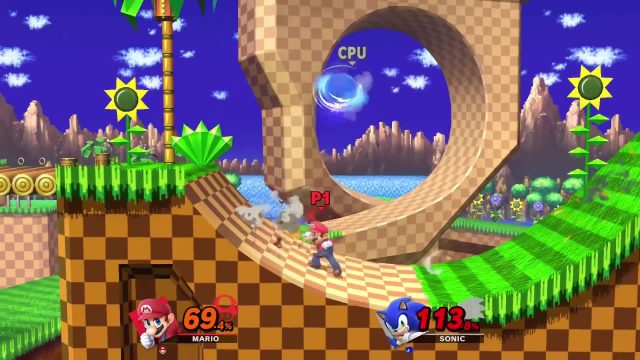
Super Smash Bros. Ultimate truly lives up to its name as well. This really is the ultimate Super Smash Bros. title in every respect, not just because it finally functions without compromise both at home and on the go, but also because it brings together the best of the series’ former fan-favourite features and fighters, while also providing a worthy amount of new content to keep the otherwise tried-and-true gameplay feeling fresh and exciting again. The online play is still a little faulty at times, and those expecting a more significant technical upgrade over Super Smash Bros. for Wii U may be disappointed, but whether you’re a longtime Super Smash Bros. fan, or are discovering the series for the first time here, a Super Smash Bros. experience truly doesn’t get better than this!
Super Smash Bros. Ultimate makes the interesting decision to fuse together the visual sensibilities of the more cel-shaded Super Smash Bros. for Nintendo 3DS, and the more grounded, technically demanding appearance of Super Smash Bros. for Wii U. Rather than cranking up the raw visual fidelity and performance to unprecedented heights, Super Smash Bros. Ultimate instead feels like a bit of a visual sidestep for the series, but one that is still incredibly technically impressive by the standards of Nintendo Switch, especially in its portable form!
The most noticeable visual upgrade throughout Super Smash Bros. Ultimate occurs in the environments, which are often given noticeably added texture definition and detail over Super Smash Bros. for Wii U. Character models have also been touched up and given great new costume flourishes, with only a few especially impressive Super Smash Bros. for Wii U character models seeing a slight downgrade (i.e. some of the Legend of Zelda characters), on account of Super Smash Bros. Ultimate ditching Super Smash Bros. for Wii U’s more technically ambitious style in favour of more cel-shaded touches. Some especially technically ambitious stages, namely Eldin Bridge, the Fountain of Dreams and the various Pokemon Stadium stages, have truly never looked more spectacular in Super Smash Bros. Ultimate though, even if the Nintendo Switch’s mobile-inspired Tegra X1 chipset means that Super Smash Bros. for Wii U still sports the visual edge with a couple of character models.
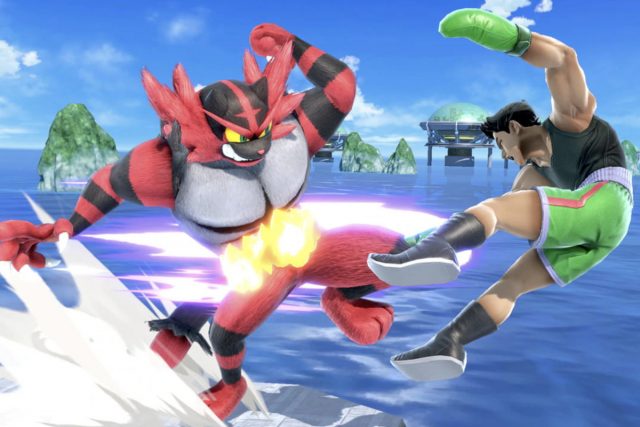
Needless to say however, Super Smash Bros. Ultimate completely leaves Super Smash Bros. for Nintendo 3DS in the dust as a portable upgrade, representing a truly massive technical leap in the move from Nintendo 3DS to Nintendo Switch! On top of expanding environments and adding tons of details to the cel-shading on various character models, Super Smash Bros. Ultimate naturally also ups the resolution considerably from Super Smash Bros. for Nintendo 3DS’ paltry 240p resolution, achieving a slick native 1080p resolution when played on a television, and a full-powered 720p portable resolution in Handheld Mode. The fact that the visuals look just as good on the Switch’s handheld screen as they do on a television, even with the expected resolution downgrade in Handheld Mode, is a huge testament to the technical chops of the Nintendo Switch hardware, which finally provides an uncompromised, full-scale Super Smash Bros. experience on the go!
Performance is also key in Super Smash Bros. Ultimate, and fortunately, the game excels here as well. Super Smash Bros. Ultimate achieves effortless and consistent 60fps performance both on a television and in Handheld Mode, which is never disturbed in virtually any circumstance. Gameplay is smooth and satisfying throughout, even in full eight-player matches within technically challenging arenas. Just about every player will love the way that Super Smash Bros. Ultimate controls and handles! As far as the game’s esports prospects go though, it’s still noticeably trailing the fast, manic and intense gameplay of series darling, Super Smash Bros. Melee for GameCube. Super Smash Bros. Ultimate continues to slightly increase movement and attack latency, meaning that it will once again require some adjustment for competitive players, who will find a few microseconds’ added difference in their battle plan compared to Super Smash Bros. for Wii U. The very slight added latency over Super Smash Bros. for Wii U is nowhere near noticeable enough to detract from Super Smash Bros. Ultimate as an overall experience, but it’s still frustrating that the series’ ever-deepening beauty always seems to continue increasing input lag with every new post-Melee installment, even by microseconds.
Super Smash Bros. Ultimate continues the series’ tradition of combining many disparate remixes and original tunes of music across its stages, almost all of which can now be listened to and enjoyed right from the very beginning, via the Sound Archive! This has Super Smash Bros. Ultimate continuing to deliver the best buffet of high-quality gaming music that players could imagine, across all of Nintendo’s fan-favourite franchises, as well as featured third-party offerings like Sonic the Hedgehog, Mega Man and Metal Gear Solid. There are some all-new musical compositions to enjoy in new and returning stages throughout Super Smash Bros. Ultimate too, namely to accommodate debuting franchises such as Splatoon and Castlevania. Players will also freely be able to toggle their favourite stage tunes’ frequency when setting up local Smash battles with their friends, so long as they’re within the featured franchise of their preferred stage. The big highlight is of course Super Smash Bros. Ultimate’s lyrical theme song, “Lifelight”, composed by Yakuza series veteran, Hideki Sakamoto, which is offered in both English and Japanese variations, and sounds great in either format!
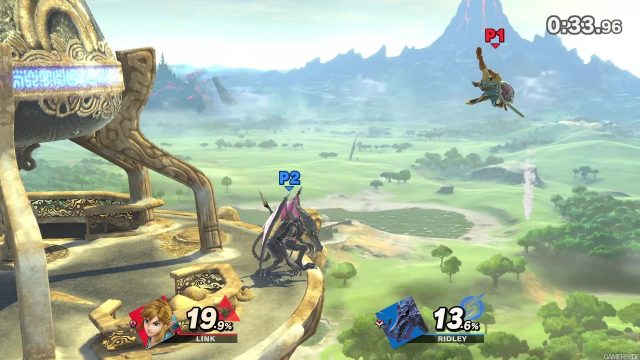
The rest of the audio effects are more or less par for the course for any Super Smash Bros. game, which is to say that they sound pretty fantastic! The explosive, hard-hitting battles throughout Super Smash Bros. Ultimate walk the perfect line between painful domination and cartoon-ish fun, as do environmental features, audio cues and any other such sound flourishes that can be enjoyed as you play. Just like the music, there’s a bit of a mix of styles in the audio, namely through nostalgic and retro audio notes combining with more modern, impressive-sounding audio effects, though it’s all a delight to listen to. Some fans may also be pleased to see that Fire Emblem personalities, Roy and Marth have also gained English voiceovers in Super Smash Bros. Ultimate, alongside Final Fantasy VII’s Cloud, after they were formerly restricted to Japanese voiceovers, allowing them to perfectly fit with the humourous taunts and voice cues from the other characters. Those playing in Handheld Mode will definitely want to plug in a good pair of headphones, since Super Smash Bros. Ultimate sports one of the most impressive audio jobs of any Nintendo Switch game released throughout 2018, and perhaps any 2018 video game overall!
The fundamentals of Super Smash Bros. continue to remain intact in Super Smash Bros. Ultimate; Two to eight players, depending on your setup and preference, compete in either Time, Stamina or Stock-style matches to damage their opponents, making them easier to drop or launch them out of the arena, in order to score a point. In Time matches, players must successfully ‘defeat’ their opponents in this manner the most within a set time limit, while Stamina-based matches have players competing to drop the health percentage of their opponents down to 0%, and elimination-style Stock matches instead give players a limited amount of lives, which see them removed from play once they’re exhausted, eventually leaving a last fighter standing that will be declared the winner. This fundamental play style has been in effect since the Super Smash Bros. series’ origins on Nintendo 64, and as you can imagine, Super Smash Bros. Ultimate certainly isn’t fixing what isn’t broken.
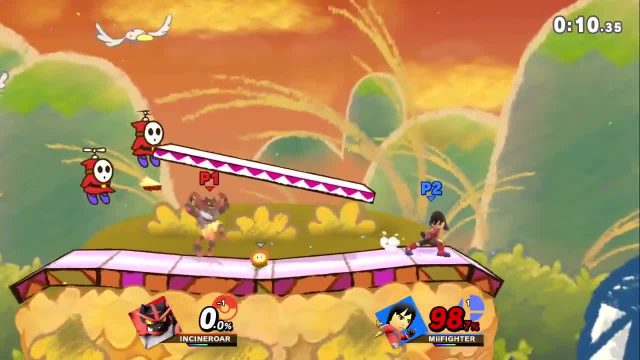
Super Smash Bros. Ultimate however takes every highlight from the series’ gameplay evolutions over the years, and brings it all together into the most versatile, user-friendly Super Smash Bros. experience to date! There certainly isn’t much left on the table in this new installment, with the absence of the series’ myriad trophy collectibles probably being the biggest gameplay element that Super Smash Bros. Ultimate ends up removing, despite it being the most frequent reward suite in the past several games. The trophies have instead been replaced by a new ‘spirit’ mechanic, which allows players to unlock, feed and train the ‘spirits’ of various Nintendo and third-party game characters, after they have been displaced from their game universes by Adventure Mode antagonist, Galeem. The key hook with spirits is that they can be used to enhance the skills and stats of your fighters in Adventure More, and the dedicated Spirit Board mode, giving you potentially unlimited means of customizing your Smash matches between the game’s 1,000+ spirits, which can be equipped as both Primary stat-enhancing spirits, as well as Support skill-enhancing spirits. It’s impossible to sum up the sheer depth of the spirit system in one review, but it’s a great feature that keeps on giving in Super Smash Bros. Ultimate, essentially granting you the most free reign to design and overcome whatever unique challenges you want during the course of gameplay, even approximately simulating characters that aren’t available to play as in this game!
The spirit mechanic initially seems daunting and complex, and players can opt to ignore it in both local and online Smash sessions, if they so choose. The spirit mechanic does however prove to be a superior upgrade over trophies in the end, thanks to how it keeps allowing gameplay challenges to evolve and change, particularly in the surprisingly robust and lengthy set of challenges in Adventure Mode. Players can assign a ‘Primary Spirit’ to their chosen fighter, which can be fed treats to level it up, granting greater stat boosts and enhancements for capabilities such as dealing damage, absorbing damage or moving quickly, with each Primary Spirit having a certain amount of slots for Support Spirits. Support Spirits can grant any number of unique perks, such as starting fighters off with certain items, increasing their jump speed, or granting regenerating health, among many other possibilities. You win spirits by triumphing in Spirit Battles within the game’s Spirit Board section, as well as in Adventure Mode, where they often give you the best means of gaining an edge over the many unpredictable challenges in both modes. Some spirits can also be obtained through special events and play history unrelated to your Super Smash Bros. Ultimate achievements, such as special Pikachu and Eevee spirits being granted to players who have Pokemon Let’s Go save data on their Nintendo Switch memory, for example.
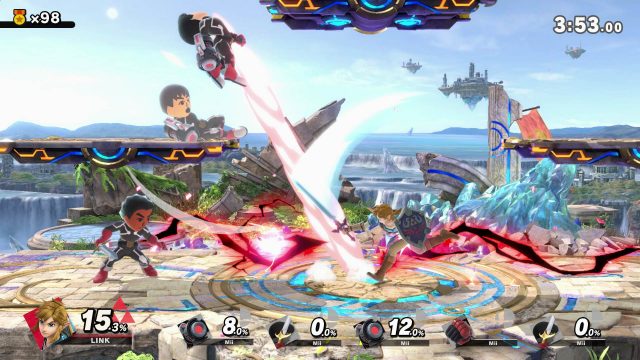
The biggest selling point regarding Super Smash Bros. Ultimate trying to bring everything else into one title however is that absolutely every playable fighter in the series’ history is featured as a playable fighter in the base game, including one-off characters like Super Smash Bros. Melee’s Pichu and Super Smash Bros. Brawl’s Solid Snake, as well as paid DLC fighters from Super Smash Bros. for Nintendo 3DS and Super Smash Bros. for Wii U, such as Bayonetta, and Street Fighter’s Ryu. This also means that fan-favourite dual character team, the Ice Climbers also make a return in Super Smash Bros. Ultimate, after being removed from the series’ previous Nintendo 3DS and Wii U entries due to technical limitations. Not only that, but several all-new fighters are unlockable in the base game as well, including Castlevania’s Simon Belmont, Pokemon’s Incineroar, and Donkey Kong Country’s King K. Rool, for example. Super Smash Bros. Ultimate also offers a ‘Fighters Pass’ for purchase via the Nintendo eShop, which grants access to five paid DLC fighters in the near future (though only one has currently been revealed, that being Persona 5’s Joker), while early purchasers will score a free download for another all-new playable Nintendo character, the Mario series’ Piranha Plant, a character that will have to be paid for if you buy Super Smash Bros. Ultimate after the end of January.
To start however, you only have access to the base eight-fighter roster from the original Super Smash Bros. game for Nintendo 64, namely Mario, Donkey Kong, Link, Samus, Pikachu, Kirby, Yoshi, and Fox. Every other fighter must be challenged, defeated and unlocked by performing a variety of gameplay tasks, whether it’s completing a Classic Mode run with certain characters, fighting a certain amount of Smash matches with your friends, or, the most efficient method, defeating the fighters in Adventure Mode. This is a progressively rewarding and surprisingly fun system that allows players to explore all levels of Super Smash Bros. history on unpredictable terms, while also constantly giving them new characters to discover and conquer. There’s also an inspired sense of gradually building skill to boot, since every fighter you unlock makes subsequent new fighters more challenging and competent, and more difficult to gain access to! If you lose a battle against a fighter that you’re attempting to unlock, you’ll have to wait for a rematch opportunity to show up in Super Smash Bros. Ultimate’s menus as well, which is a bit annoying, though it does at least help you stay on your toes as you try to complete the game’s massive roster of 74 fighters in the base product, not including paid DLC fighters to come.
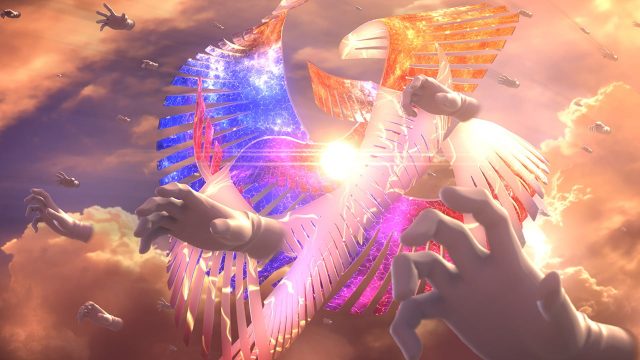
Many of the fighters maintain their familiar movesets, though there are obviously some tweaks and additions to help them stand out in Super Smash Bros. Ultimate. Sometimes, this is done with mere costume expansions, such as Mario being able to wear his construction costume from Super Mario Maker or his wedding costume from Super Mario Odyssey, for example. Other character tweaks are more significant however, such as some characters’ Final Smash moves being changed entirely in Super Smash Bros. Ultimate (particularly now that Super Smash Bros. Ultimate aims to speed up Final Smashes and make them more blunt and aggressive), or some special maneuvers now being changed to work differently, such as Link’s bombs now being remotely detonated instead of timed, or Shulk now being able to freely move between Monado Arts using a single command, rather than multiple cycling commands. Small tweaks like this help create strong new spins on established characters, as do the newly-declared Echo Fighters, which function as fighters with similar movesets as others, though with tweaked stats and taunt personalities than the fighters that inspired them, with examples including Pit and Dark Pit, Marth and Lucina, and Peach and Daisy.
The all-new fighters fit in perfectly with the old favourites, with each having their own unique play styles and quirks. The Inklings from the Splatoon series are among the most noteworthy new fighters, since they maintain their diverse, ink-based weapons from the Splatoon games, and can have their opponents take more damage by inking them, though they will run out of ink if players don’t duck into an ink pool and tap the B Button, providing an interesting trade-off to their versatile means of combat. Simon and Richter Belmont from the Castlevania series are also big highlights, maintaining the series’ familiar weapons such as the Vampire Killer whip, along with sub-weapons like the axe, cross and holy water, which are used with the familiar rigid movement of the classic Castlevania games, though with the trade-off of the Belmont men being two of the strongest fighters in the game. All of the new fighters are a joy to discover and master, and they all pack in diverse and interesting specializations, even if some, like Incineroar and the aforementioned Belmont fighters, definitely take some practice to use well, on account of their highly specific combat maneuvers.
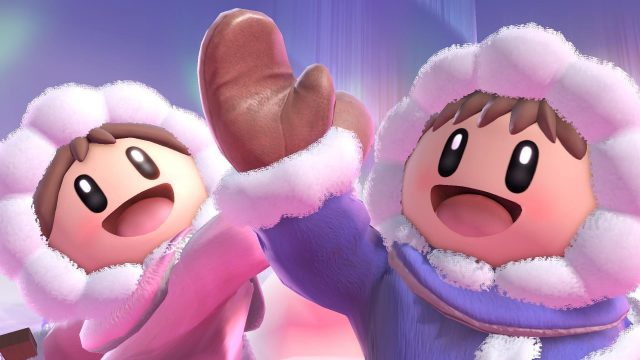
The huge roster of varied arenas also constantly lends unpredictable and exciting obstacles to each match-up, particularly now that Super Smash Bros. Ultimate gives each featured stage a ‘Battlefield’ and ‘Omega’ variant as well (all of which can be played with eight players too), allowing players to streamline and narrow the field of combat by modifying or disabling stage obstacles, if they want to place the most emphasis on direct, skill-based battles. This includes old favourites like Princess Peach’s Castle, Planet Zebes and Kongo Jungle, as well as all-new additions such as Splatoon’s Moray Towers and The Legend of Zelda: Breath of the Wild’s Great Plateau Tower. No matter how you want to play, Super Smash Bros. Ultimate has you covered. The Special Smash Mode is especially fun to mix and match with arenas, allowing players to set up matches with heavy gravity, all fighters being metal, all fighters perpetually spitting fire with permanent Spicy Curry in effect, or other eccentric challenges to keep developing your skills. This rewarding sense of novel challenge also comes by way of intelligent, yet subtle modifications to how fighters utilize competitive maneuvers like dodging, such as players now being punished with diminished intangibility times for excessive dodges, or players now taking more damage with the same attacks when fewer fighters are in a match, among a few other small updates to the basic fighting mechanics.
It’s truly amazing how well Super Smash Bros. Ultimate upholds the series’ simple gameplay appeal, while also making it infinitely complex, fully-featured and rewarding for players who really want to sink their teeth into what the game has to offer! You won’t hit too many limits in trying to customize your preferred Super Smash Bros. experience here, particularly when playing locally with friends, which often results in the most raucous and fun match-ups, as per usual. The one exception to this rule of flexibility and convenience however seems to be the online play, which, while having improved somewhat with patching, is still an uneven and unreliable slog in many respects. Some online matches will go off without a hitch, and are virtually indistinguishable from local play, but others are plagued with gameplay lag and disconnects, making it a crapshoot as to whether you’ll enjoy a smooth online experience, or a positively unplayable one. Making matters worse is the unfortunate necessity of paying for the currently lacklustre Nintendo Switch Online service to take on online opponents in Super Smash Bros. Ultimate to boot, which forces you to use the Nintendo Switch Online smartphone app for crude and uncomfortable voice chat. Failing that, you have to use your Control Pad to declare pre-determined text messages between matches. Needless to say, that’s not very satisfying for hardcore players especially.
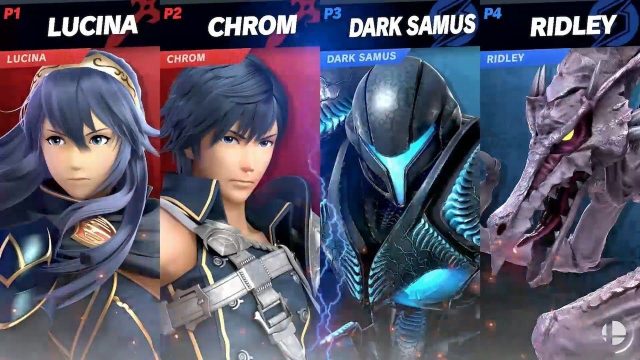
Outside of some of the hiccups with online play however, it’s tough to complain about any element of Super Smash Bros. Ultimate in great detail, since it’s so extensively polished and customizable. Even if you don’t like certain play modes, you have other options when it comes to unlocking fighters, for example. You can choose to completely neglect the modes that you don’t want to play, both online and offline, and while the online matchmaking won’t always provide perfectly-tuned match-ups (another problem with Super Smash Bros. Ultimate’s somewhat shaky online component), you can create custom rulesets for both local and online play, allowing you to craft Super Smash Bros. Ultimate into whatever experience you see fit. The game truly lives up to its name as the most fully-featured and flexible Super Smash Bros. game to date, once again providing a perfect fusion between a deep, satisfying and unique fighting game experience, as well as a lively social party game that constantly invites replaying and experimenting.
Super Smash Bros. Ultimate aspires to be the very best Super Smash Bros. game to date, and for the most part, it succeeds. There are a handful of elements that may have been better achieved in certain former Super Smash Bros. titles, whether it was a few more impressive visual elements in Super Smash Bros. for Wii U, or the heightened gameplay responsiveness that still remains best realized in Super Smash Bros. Melee from almost two decades ago, but as an overall package, Super Smash Bros. Ultimate truly stands as the culmination of everything noteworthy that Super Smash Bros. has ever achieved as a series! This game rivals, and perhaps even surpasses any other multiplayer-driven experience on Nintendo Switch that you could currently name (probably a lot of the single-player ones too!), and is sure to be a constantly revisited crowd favourite both throughout and after the Nintendo Switch’s life cycle.
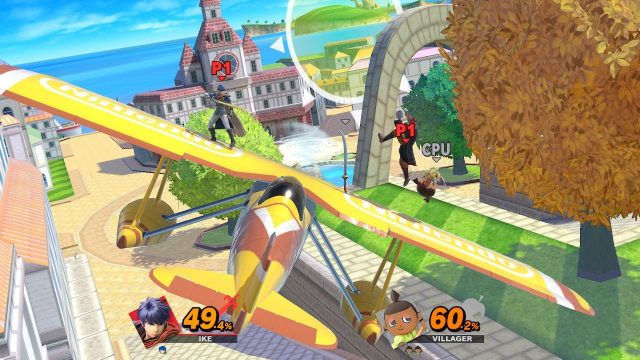
Super Smash Bros. Ultimate is so ambitious and fully-featured in fact that it seems initially impossible to top, making one wonder where the Super Smash Bros. series may ultimately be able to go in a future installment. For now though, this game easily stands as one of the Nintendo Switch’s best exclusives of 2018, if not the best, as well as an easy contender for one of 2018’s best fighting games overall! Had the online play not ended up so finicky at launch, Super Smash Bros. Ultimate would be nigh on flawless, and that’s at least true in virtually all respects throughout every portion of the feature-packed offline gameplay. Standing as both the ultimate love letter to Nintendo fans as well as the ultimate mascot fighter, the word, “Ultimate” has perhaps never felt more appropriate for a video game. Regardless of what kind of Nintendo Switch player you are, Super Smash Bros. Ultimate simply demands to be part of your game collection!
This review is based on a copy of, “Super Smash Bros. Ultimate” provided by publisher, Nintendo

